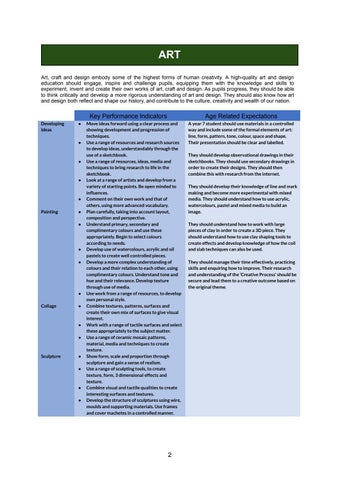ART Art, craft and design embody some of the highest forms of human creativity. A high-quality art and design education should engage, inspire and challenge pupils, equipping them with the knowledge and skills to experiment, invent and create their own works of art, craft and design. As pupils progress, they should be able to think critically and develop a more rigorous understanding of art and design. They should also know how art and design both reflect and shape our history, and contribute to the culture, creativity and wealth of our nation.
Key Performance Indicators Developing Ideas
●
●
●
●
● Painting
● ●
● ●
● Collage
●
● ●
Sculpture
● ●
● ●
Age Related Expectations
Move ideas forward using a clear process and showing development and progression of techniques. Use a range of resources and research sources to develop ideas, understandably through the use of a sketchbook. Use a range of resources, ideas, media and techniques to bring research to life in the sketchbook. Look at a range of artists and develop from a variety of starting points. Be open minded to influences. Comment on their own work and that of others, using more advanced vocabulary. Plan carefully, taking into account layout, composition and perspective. Understand primary, secondary and complimentary colours and use these appropriately. Begin to select colours according to needs. Develop use of watercolours, acrylic and oil pastels to create well controlled pieces. Develop a more complex understanding of colours and their relation to each other, using complimentary colours. Understand tone and hue and their relevance. Develop texture through use of media. Use work from a range of resources, to develop own personal style. Combine textures, patterns, surfaces and create their own mix of surfaces to give visual interest. Work with a range of tactile surfaces and select these appropriately to the subject matter. Use a range of ceramic mosaic patterns, material, media and techniques to create texture. Show form, scale and proportion through sculpture and gain a sense of realism. Use a range of sculpting tools, to create texture, form, 3 dimensional effects and texture. Combine visual and tactile qualities to create interesting surfaces and textures. Develop the structure of sculptures using wire, moulds and supporting materials. Use frames and cover machetes in a controlled manner.
2
A year 7 student should use materials in a controlled way and include some of the formal elements of art: line, form, pattern, tone, colour, space and shape. Their presentation should be clear and labelled. They should develop observational drawings in their sketchbooks. They should use secondary drawings in order to create their designs. They should then combine this with research from the internet. They should develop their knowledge of line and mark making and become more experimental with mixed media. They should understand how to use acrylic, watercolours, pastel and mixed media to build an image. They should understand how to work with large pieces of clay in order to create a 3D piece. They should understand how to use clay shaping tools to create effects and develop knowledge of how the coil and slab techniques can also be used. They should manage their time effectively, practicing skills and enquiring how to improve. Their research and understanding of the ‘Creative Process’ should be secure and lead them to a creative outcome based on the original theme.

